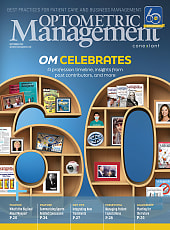coding strategies
A Rational Method for Setting Fees, Part 1
BY CLARKE D. NEWMAN, OD, FAAO
For the past 10 months, we have discussed at length the ins-and-outs of billing for medically necessary contact lenses. So, as a change of pace, for the next two months we will talk about ethical billing for cosmetic contact lenses.
When we're talking about medically necessary lenses, we're talking about basic billing and coding. Each of the codes comes with a limiting charge based on the fee schedule and the locale.
When thinking about materials, we just want to make sure we cover the material and the administrative costs. Even then, sometimes we have to contend with fee schedules.
Not so with cosmetic lens prescribing.
Start with the Right Mind Set
Let me say this right here and now. We cannot ever get together and decide to do anything relating to fees — that would be antitrust. When I speak about setting fees, I mean that each of you should, independently, review your practice and set your fees in a rational, ethical and profitable manner.
Okay, back to business. Very few of us have any problem contemplating what an ethical fee structure is. Where we practitioners, with our limited business sense, get into trouble is with the rational and the profitable part. Just as with medically necessary contact lenses, we must resolve to be profitable in the rest of our business. Right, but how?
First, let's get a rational handle on how to set fees. If we don't do that, then we can't ensure that we are profitable. So, we need to discuss "chair costs" and "staff hours."
Calculating Costs
"Chair costs" is the calculation of what it costs to run your business. Very few of us actually do this number crunch, but it is necessary for determining a rational and profitable fee schedule.
Your chair cost is the practice gross profit minus the cost of goods sold minus the net profit (your take-home pay and benefits) divided by the number of patient encounters.
Let's say that in 2007 your practice grossed $1,000,000, your material costs during that period were $275,000, you took home $250,000 and you worked 248 days, performing, on average, 10 "exams" per day and 10 "follow ups" per day. Follow ups are counted roughly as half-exams, for a total of 15 encounters per day.
Using the calculation I mentioned earlier, we end up with a chair cost of $128. In this example, the practitioner has a relatively low cost of goods, but a slightly lower-than-average take-home due to higher "fixed costs" — not uncommon in large grossing, solo practices.
"Staff hours" refers to the time invested in each activity. Staff hours tell us how many of those activities we can fit in a day. Roughly speaking, the rule is that each staff member's time is equal to one-half of the practitioner's time. If you know how much each patient encounter costs, and you know how many staff members it takes to complete an encounter, such as prescribing a hydrogel toric, then you are armed with what you need to create a rational and profitable fee schedule.
The more staff you have, the more of these encounters you can have if the staff can do the task. Not only can you use this information to create fees, but you can also use it to help with staffing decisions and with staff resource allocation.
More to Come
Next month, we will take this information and create a fee schedule that is fair to our patients and profitable for us. CLS
Dr. Newman has been in private practice in Dallas, Texas since 1986 specializing in vision rehabilitation through contact lenses as well as corneal disease management, optometric medicine and refractive surgery.



